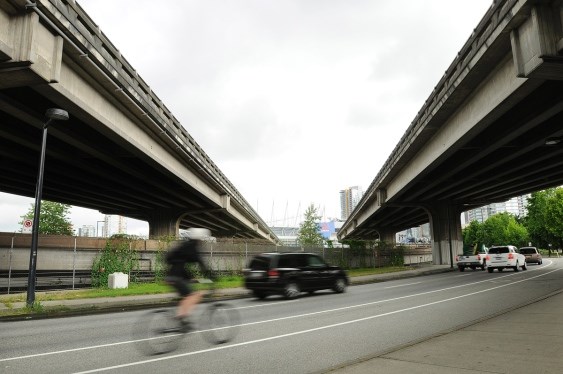Setty Pendakur was among the few dozen folks who turned up for a Vision-sponsored workshop held early Monday morning at the Roundhouse Community Centre. They were there to discuss tearing down the Georgia and Dunsmuir viaducts.
Pendakur was slower on his feet, raspier in his voice and greyer, of course, than when, as a relatively young academic transportation specialist, he got involved in Vancouver politics.
At that time, he and many others first rose up to stop the plan for a freeway through the heart of the city’s downtown. Their success, more than anything, defined the most fundamental turning point in the modern life of this city.
The viaducts are remnants of that aborted freeway plan.
Removing them is the beginning of the end of a battle Pendakur is no less determined to see through some 45 years after it all began.
At the time, the darlings of the West Side and the business community, the Non Partisan Association had controlled city hall for more than three decades.
Bill Rathie was the NPA mayor who championed the proposal to build a six-lane freeway through East Vancouver. Like many freeways slicing through the hearts of cities planned and built around North America back then, including the Gardiner Expressway in Toronto, much of this would be elevated as it ran along Cordova.
Chunks of Gastown, Chinatown and Strathcona would be sacrificed in the process. The proposal split the city and spawned a movement that would change the very nature of city government.
For the first time, Chinatown merchants and property owners flexed their muscle in what they considered a life-and-death struggle to save their homes and livelihoods. The promise by the NPA to first consult before a freeway plan was approved never happened.
A whole civic movement would be built about the need for citizen engagement. It included academics like Pendakur and Walter Hardwick, storefront lawyers including Mike Harcourt, social workers like Darlene Marzari and Chinese community activists like Shirley Chan. And it resulted in the formation of a new civic political party, The Electors Action Movement, TEAM. It would be led by a young Liberal investment broker, Art Phillips.
Change was in the air, not just in Vancouver but across the province. Established powers were threatened.
By the time the new Georgia viaduct was completed, Tom Campbell was the NPA’s mayor. His attempt to drive across the new structure in January of 1971 required a small band of cops to push back the demonstrators.
A year later — just after the NDP led by Dave Barrett ended the 20-year reign by W.A.C. Bennett’s Social Credit Party in Victoria — Phillips and TEAM, including Pendakur, Hardwick, Marzari and Harcourt, swept to power.
Phillips’ first act was to fire the head of the city’s public service. It was the end of an era when the city bureaucrats would call the shots.
Phillips recruited Ray Spaxman, a young planner from Toronto with a reputation for encouraging citizen engagement in neighbourhood plans.
While the freeway was stopped dead, the difficulty created by the new viaducts would remain to this day — including cutting Chinatown off from surrounding neighbourhoods and turning Prior Street, as it ran through Strathcona, into a major traffic artery that divided that community.
The desire to tear down those structures, to regain the land they occupy for parks and affordable housing, to restore some tranquility to Strathcona have yet to be satisfied.
In the meantime, every senior planner at the city since has advocated for their removal. Engineering staff has managed to figure out a way to both remove the viaducts and still ensure the flow of traffic into and out of the city.
And the desire amongst affected neighbourhoods and activists has never faded. At council, former Strathcona resident and Vision councillor Geoff Meggs now leads the charge for change.
And three weeks from now, council will be presented with a staff report that recommends the viaducts removal. It is unimaginable that council will refuse to give its approval.
Even so, it will be some time yet until the bulldozers can do their work. There will be at least a year of negotiations including the province and developer Concord Pacific regarding the land that will be freed up.
Finally.
@allengarr




